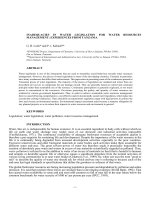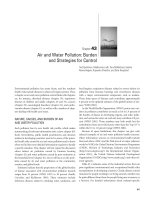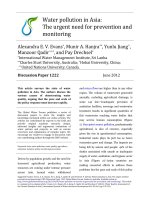Useful global databases for Hydrology and Water Resources Research
Bạn đang xem bản rút gọn của tài liệu. Xem và tải ngay bản đầy đủ của tài liệu tại đây (1.44 MB, 23 trang )
Presented By:
A. T. Kabo-bah
E:
April 30, 2012
Hohai Research Forum, China
1. There is growing free datasets prepared for
hydrologic and water resources modelling world-
wide
2. Already prepared datasets that can be easily
imported into our MODELS
3. Datasets can reduce the time spend – SEARCHING,
FRUSTRATION of getting the right data & the
psychological pressure on NOT meeting research
deadlines because of lack of “required data”
4. Processing time spend maybe reduced with global
datasets
5. Increases our chances of obtaining independent
datasets for validation our models
1. Field measurements
2. Spatial measurements – using satellite datasets
(L1, L2, L3, L4)
3. Advanced Processed Datasets – combined data
4. Other datasets – socio-economic data, climate
change scenarios
Stream Flow
Rainfall, Snow
Humidity
Temperature
Soil moisture
Eddy covariance – Towers (Evapotranspiration, soil
moisture, groundwater)
Etc.
/>verdata/
/>•
Annual average temperature (°C)
•
Annual average maximum temperature (°C)
•
Annual average minimum temperature (°C)
•
Total annual precipitation of rain and / or snow (mm)
•
Annual average wind speed (Km/h)
•
Total days with rain during the year
•
Total days with snow during the year
•
Total days with thunderstorm during the year
•
Total days with fog during the year
•
Total days with tornado or funnel cloud during the year
•
Total days with hail during the year
Global data - 1970 – date, vary for different countries
-
average annual climate
characteristics of meteo stations
-climate change grids.
Eddy covariance is a key atmospheric measurement
technique to measure and calculate vertical
turbulent fluxes within atmospheric boundary layers
Evapotranspiration studies, transpiration,
groundwater studies
/>ites/EOS-Botswana-Kalahari-site.html
: Tower in Bostwana
/>tes/China-Tibetan-plateau-site.html
: Tower in China
/>tes/Netherlands-Lattrop-site.html
: Tower in the Netherlands
Typical measurements: radiation and microclimatic
conditions, sap flow at various species, unsaturated
zone moisture and matric potential and water table
fluctuation.
:
ONLY for AFRICA
Check out: Real-time Google Earth Global
Precipitation Mapper
L1 data – typically raw data - usually not usable
by the general public. Needs professional skill
and software to understand data
L2, L3 data – processed data and converted into
usable public formats
LANDSAT – land surface fluxes e.g. NDVI, NDWI etc.
ASTER – land surface fluxes, Digital Elevation Model
GRACE – Water Storage, Gravity variation, Water
balance studies
MODIS – land surface fluxes, derived land surface fluxes
(emissivity, albedo, surface temperature etc)
SPOT /QUICKBIRD– High resolution land surface
mapping, urban planning, 2.5-10M DEM
NOAA/AVHRR – Land surface fluxes
MERIS – high spectral resolution – water quality
assessment
Many others…
List of types in this database:
/>
Generally, data includes land surface fluxes and
canopy-atmospheric boundary layer indicators.
/>
Administrative
boundaries
Rivers, Roads,
Railways
Land cover
Emissitivity
Albedo
Land surface temperature
DEM
Etc.
: Derive land
products
: Important related
products produced by FAO for Africa.
: Important resource
: search engine for free
satellite data
: Global 90m DEM
: Gravity
Recovery and Climate Experiment
: Global
monitoring of soil moisture – data available now in
experimental mode.
Atmospheric data sources
Thank you!









